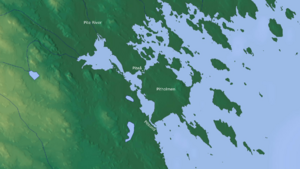Battle of Piteå facts for kids
Quick facts for kids Battle of Piteå |
|||||||
|---|---|---|---|---|---|---|---|
| Part of the Finnish War | |||||||
 Locations of the Battle of Piteå |
|||||||
|
|||||||
| Belligerents | |||||||
| Commanders and leaders | |||||||
| Strength | |||||||
| The frigate Jarramas 6 cannon sloops |
One infantry battalion One unit of cossacks |
||||||
| Casualties and losses | |||||||
| 6 killed 19 wounded |
13 killed 20 wounded 7 captured |
||||||
The Battle of Piteå happened on August 25, 1809. It took place near Piteå, Sweden. This battle was part of the Finnish War. A Swedish naval force tried to stop a Russian army from escaping. The Russians had been defeated a few days earlier. The Swedes wanted to trap them. However, the Russians won this battle. It was the last battle of the war fought on Swedish land.
Contents
Why the Battle of Piteå Happened
The Finnish War and Retreat
The Battle of Piteå was part of the Finnish War. This war was fought between Sweden and Russia. On August 20, 1809, the Russian army lost a battle. This happened at a village called Ratan, north of Umeå. After their defeat, the Russians started moving north. They were heading towards Piteå.
Sweden's Plan to Trap the Russians
A Swedish naval force decided to follow the retreating Russians. This force left Ratan on August 23. It was led by Major C.F. von Hauswolff. His main ship was a frigate called the Jarramas. Six smaller 'cannon sloops' also joined them. Their mission was to cut off the Russian escape route. They planned to reach the northern shore of the Pite River. There, they would destroy a bridge. This would trap the Russian army. They would be stuck between the Swedish naval force and the main Swedish army to the south.
What Happened During the Battle
Arrival at Pitholmen
The Swedish ships arrived south of Piteå on August 25. They reached an island called Pitholmen. Their goal was also to capture any Russian ships they found. On the island, they saw Russian soldiers. There was an infantry battalion and some cossacks. General Nikolay Kamensky was in charge of these Russian troops.
First Shots Fired
When the Russians saw the Swedish ships, a soldier was sent. He was ordered to quickly ride his horse. His job was to spread the news of the Swedish arrival. But he was shot and killed by fire from one of the Swedish sloops. The bridge the Swedes wanted to destroy was easy to see. It looked like it could be destroyed by cannons from the sloops.
Major Hauswolff's Injury
Major Hauswolff decided to destroy the bridge himself. He got into a small boat. He started rowing towards the bridge. Soon, he came under fire from Russian guards on the beach. He was badly injured during this attempt.
Swedish Attempts to Advance
After Major Hauswolff was hurt, Georg Samuel von Gegerfelt took command. He tried to steer the Swedish ships into the narrow strait. This strait led towards the bridge. But Russian infantrymen attacked them from both sides. A Swedish officer, Lieutenant Everlöf, tried to reach the bridge. He advanced with some sloops protecting him. However, he and his men were shot down. The Russians were on higher ground. The Swedes realized they had to retreat.
Russian Reinforcements Arrive
The Swedes then saw thirteen Russian transport ships. These ships were coming from the south. They were bringing supplies for the Russian land forces. Two Swedish sloops were sent to attack these ships. But the sloops had to retreat quickly. The transport ships were guarded by two strong cannon boats. The Swedish squadron realized their situation was hopeless. They quickly pulled back to the south.
After the Battle
Casualties and Plunder
The Battle of Piteå was a Russian victory. However, both sides had losses. Six Swedish soldiers were killed and nineteen were injured. On the Russian side, thirteen were killed, twenty were injured, and seven were captured. These numbers show that the battle was not a huge victory for the Russians. Despite this, the Russians went into Piteå. They plundered the town after the fight.
Remembering the Battle
In 1999, a special marker was placed at the battle site. This marker recognizes the battle's importance. It was the last fight of the war on Swedish land. In 2009, the Swedish King Carl XVI Gustaf visited the site. He laid a wreath there. The Russian ambassador to Sweden, Alexander Kadakin, also laid a wreath.
Images for kids


